10 Android Testing Frameworks: The Way Your App Becomes A First-Rate Product
Updated 06 Jun 2023
9 Min
3340 Views
When we use an attractive and thoroughly developed Android app, we usually don't ponder on how it has been created. But before the app is released, it evolves from the original idea to the elaborated project. And the testing is one of the most crucial stages of the app development. Due to the QA testing, the app can be verified for presence or absence of any bugs. Moreover, QA engineers can also check the performance level and thought-out UX of the app.
So how are Android apps tested? They are tested using special frameworks and other tools that can help perform the testing at the highest level and fix all bugs before it is released. That is why testing service means a lot for any software development service company, and we are not the exception to this rule. What frameworks do we use for Android app testing? You are here to figure it out.
Android UI frameworks for automated testing
First, we would like to speak about UI frameworks for automated testing. User interface testing makes it possible for QA engineers to see whether the app meets the UI standards, how it was implemented etc. Mobile app automation testing is considered to be one of the most accurate testing types.
Robotium
Robotium is a framework for testing Android apps that allows QA engineers create test scenarios for functional, systematic and behavior testing. In fact, this framework gives the opportunity to perform gray box testing.
It is a reliable and well-known tool. The framework is constantly being updated, and it's performance is improved after each update. Robotium Android testing is provided in the form of a JAR file to be compiled with your project.
Know everything about testing types. Read Basic and advanced software testing services: What's the difference?
Pros:
- You need minimum time to write solid test cases;
- You can create good test cases with the minimal knowledge of the app tested;
- Framework can process a few testing processes for Android automatically;
- Automated synchronization;
- Quick testing implementation;
- Tests are more reliable due to runtime binding to UI components.
Cons:
- Time-consuming;
- It doesn't offer screenshots feature;
Espresso
This framework for Android application testing is created for developers that consider automated testing as the component of system development lifecycle. For those who are skilled in coding a bit, testing will take less time. The tool has a programming interface that is simple-to-understand and it can be changed if necessary since the framework is open-source.
Pros:
It is designed for white-box testing. Despite the fact you need to be familiar with the app tested and understand the code, Android Espresso tests are running fast and they are reliable. But it can test only one app at a time.
- Espresso API tests are displayed as a common English text, so you can learn to work with it very fast;
- It has a small API;
- It is launching fast;
- Gradle+Android Studio support.
Cons:
- It doesn't support webviews.
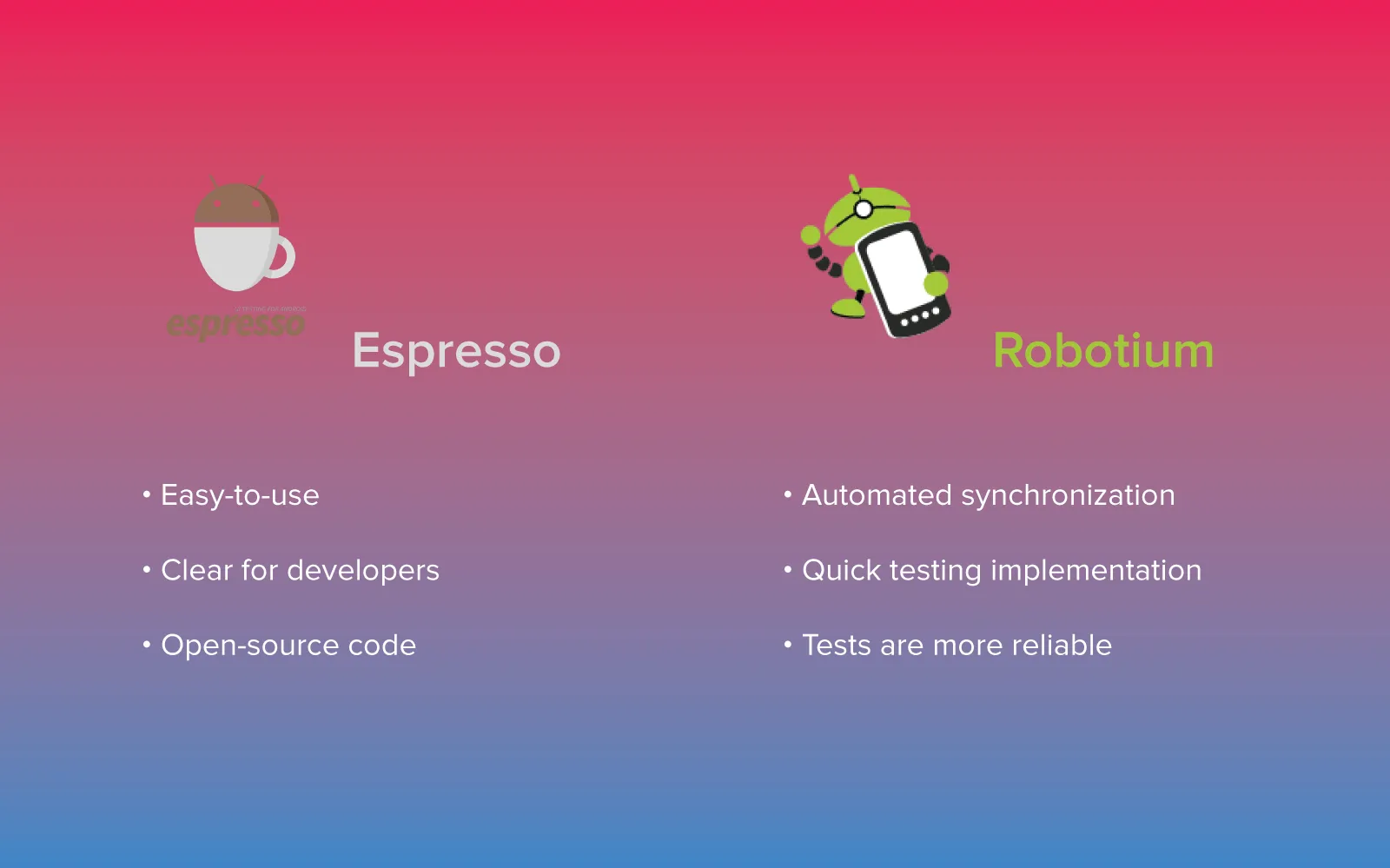
Strong sides of Espresso and Robotium frameworks
UIAutomator
UIAutomator is developed by Google corporation and supplied together with Android SDK. This framework is an analog of UIAutomation tool of Apple company but for Android test. Android SDK provides QA engineers with the following tools for automated functional testing of user interface:
- UIAutomatorviewer is a graphic tool for the recognition of UI components in Android app;
- UIAutomator is set of Java API libraries that contain methods for the creation of user interfaces tests.
To use these tools, specialists need to to have Android SDK Tools ver. 21 or higher, and Android SDK platform API 16 or higher.
Pros:
It is a black-box testing tool. UIAutomator is created only for native Android apps that is for Android auto test of apps.
- You don't depend on screen resolution;
- All actions are bound to Android UI components. It allows specialists to work directly with UI elements;
- You can start complicated sequence of actions;
- You can use external buttons on the device.
Cons:
- It works on Android devices with API 16 level or higher only;
- It doesn't support webview as well.
Learn the way we follow quality at Cleveroad. Read How do we keep up with the quality standards at Cleveroad
Appium + Python
Our QA specialists actively use the combination of Appium test framework and Python language that serves for mobile apps automation that uses Webdriver API. Appium is HTTP server that creates and manages Webdriver sessions. Python is the programming language to write scripts.
Pros:
- Appium allows to test both native and hybrid apps as well;
- Python syntax is very simple. So code can be written much faster than when you use Java language.
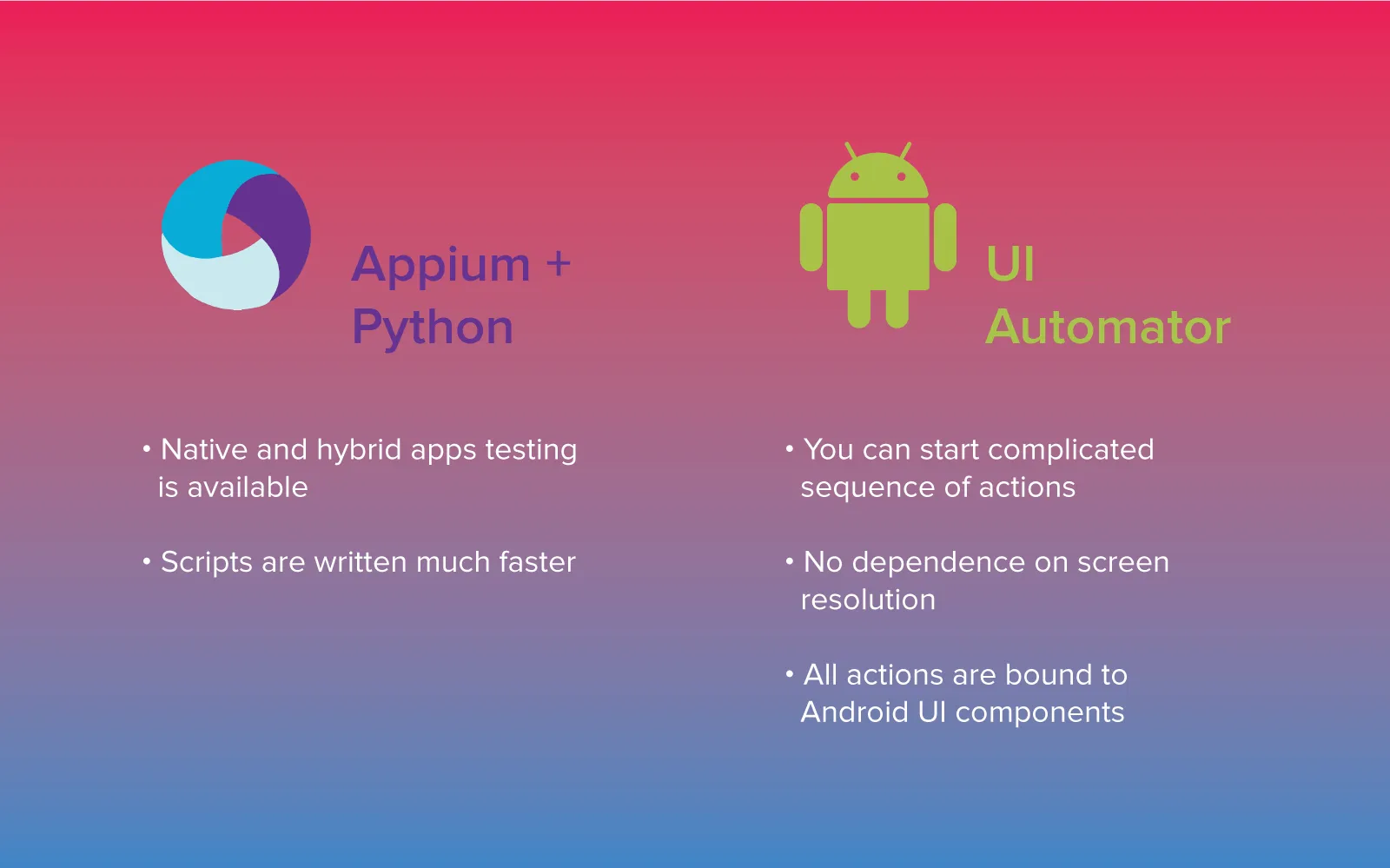
UIAutomator and Appium+Python frameworks
Cons:
- It takes some time to configure it.
Android unit testing and stress automated testing
It is the turn of some other frameworks to be mentioned. How unit and stress testing is being implemented in Android? You can find out it if you are interested in how to test an app on Android.
MonkeyRunner
MonkeyRunner Android app testing tool provides QA engineers with APIs for writing software or emulators that control Android devices. Using MonkeyRunner, you can write the script in Python that would install Android app or testing scripts unit, launch it, take UI screenshots and save it on PC.
Pros:
MonkeyRunner is developed for unit testing of devices and apps. But it also can be customized to use it for other types of Android app automation testing. It is flexible and that is the main advantage, you can implement here almost everything you need.
Cons:
- It is necessary to write scripts for each device;
We always monitor the quality level of testing. Watch more in the video below:
All you need to know about QA
Monkey
This interesting framework is the stress testing tool and it got it's name not by chance. Monkey for Android emulates the behavior when a monkey (or a baby) takes your phone and then it starts clicking all buttons chaotically.
Pros:
- You don't need source code for this testing - the app should be installed on the device or emulator;
- The main advantage of Monkey is the absence of expenses for support;
- Also, app stress-testing with random actions can help engineers detect unusual bugs.
Cons:
- It takes a lot of time to configure it.
Testdroid
This a commercial cloud solution that makes it possible to implement continuous development and testing of Android apps. This technology is used by hundreds of companies that create mobile apps and games. Android mobile app testing using Testdroid will help you find more bugs.
Pros:
- The main goal of Testdroid framework is to provide engineers with a quick result of testing;
- Immediate integration to take screenshots and add comments to them;
- It supports a wide range of mobile devices for testing.
Cons:
- It can be lagging from time to time.
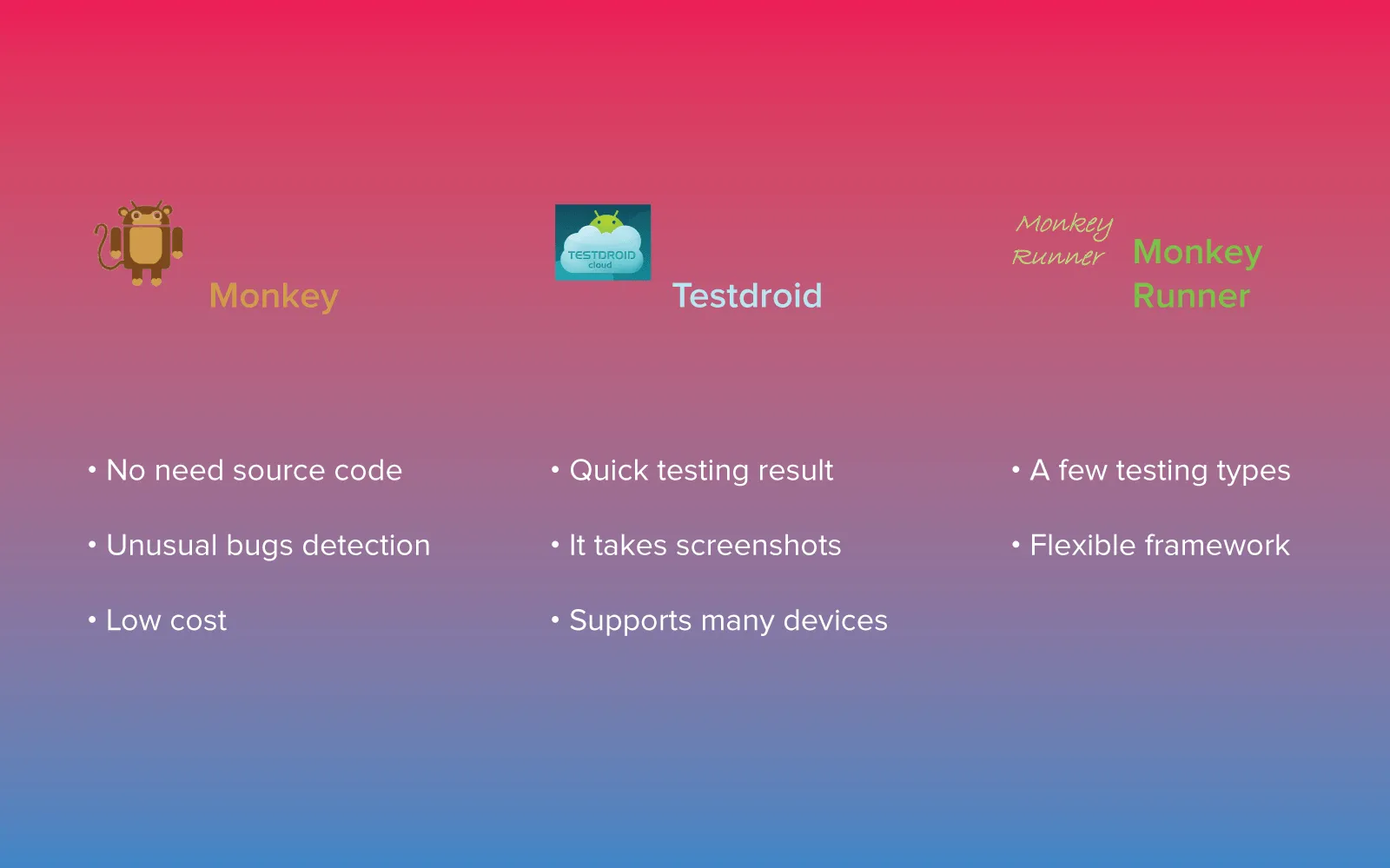
Three frameworks for unit and stress testing of your Android app
Scirocco
Scirocco framework is created to perform tests on a few devices at once and it can make test reports with screenshots automatically. It contains Scirocco plugin that is installed to facilitate Android software testing process.
Pros:
- Test reports with screenshots;
- Quick testing process;
- Solid test case is written quickly;
- Handling a few devices simultaneously.
Cons:
- You have to create extra Gradle task.
Find out more about Android frameworks for app development. Read 10 top Android frameworks that let us increase app performance and reliability
Roboelectric
It is one of Android unit test frameworks that allow QA specialists to launch tests for Android apps via local JVM. So there is no need to way to wait when APK is launched and installed. They just need to click 'Start' button and JVM is scrolling all tests quickly. There is an emulator of Android environment and the access to the main features.
Pros:
Roboelectric is rather a new framework and it is quickly developing at the moment. In most cases, it is used for business logic, data storing and data processing testing.
This Android app test type is similar to black box testing, and the test can become more efficient for refactoring, and the behavior of the app can be tested as well.
Cons:
- Some new API versions may not be available.
TestFairy
This QA automation framework for beta testing. One of the main advantages of TestFairy solution is that developer can test it quickly by himself. The developer doesn't need to integrate any SDKs or APIs into their apps. Also, the programmer just uploads APK into a system that sends invitations for beta testing to ordinary users.
After app installation, TestFairy collects key metrics from devices, CPU data, memory data, GPS, use of networking resources, phone signal level.
Pros:
When you perform beta testing of mobile apps, it can be difficult to detect why one or another problem arose. And TestFairy helps you since it records all tests on video and it memorizes all technical features of the device.
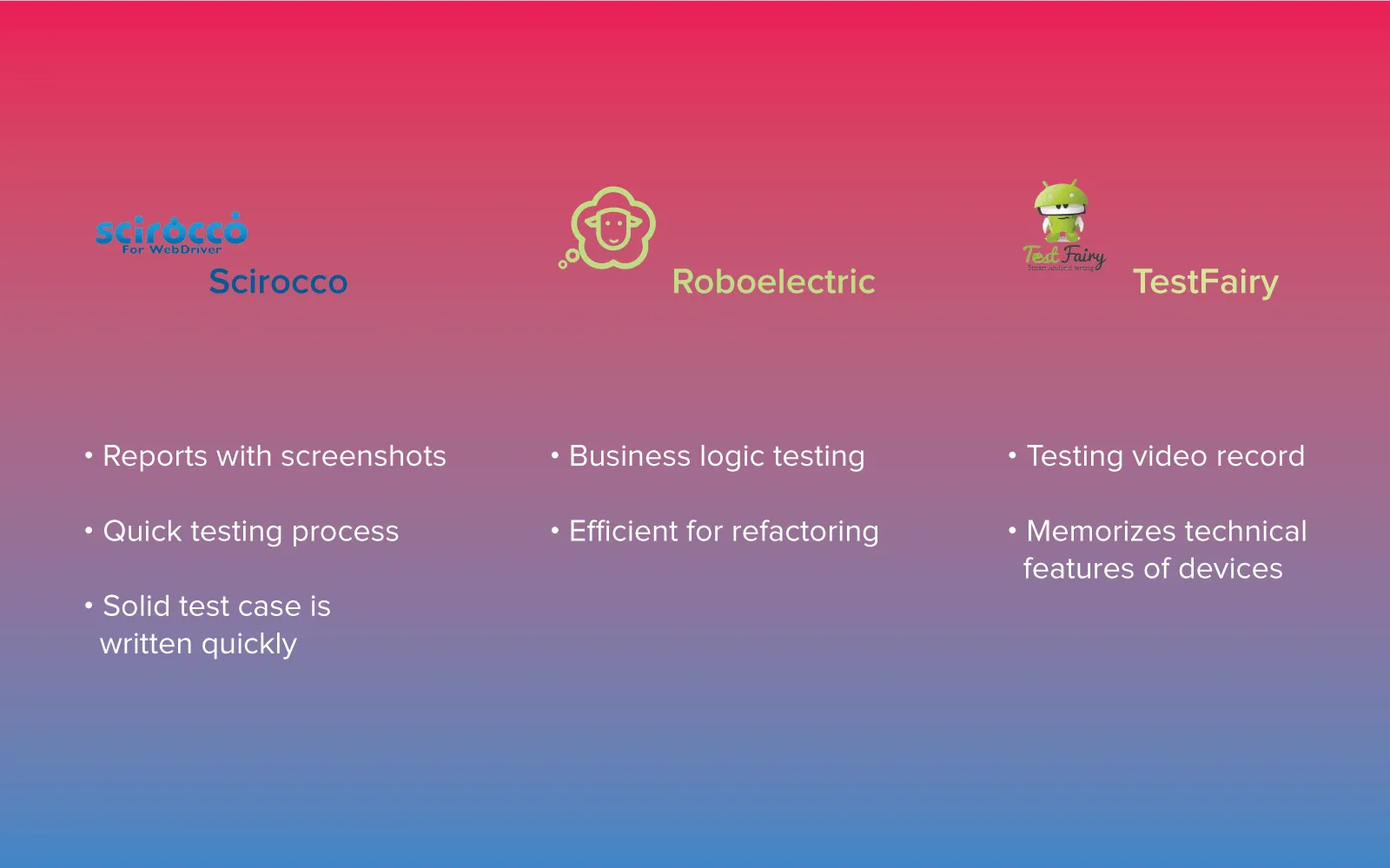
Three frameworks that make the testing process easier
Cons:
- You should manage all the testing process made by a 3rd-party user.
What else do our QA engineers use for Android app testing?
Well, that is what our QA engineers can use to test your Android app before it meets the public. But apart from automated testing, specialists also perform manual testing of Android apps. And they use a couple of tools to do it.
Android SDK
Android software development kit is used for auto test Android debugging with logs. There is a tool named Android Debug Bridge (ADB). You can communicate with a device whether it be a connected device or an emulator. It allows the specialist to work with several devices simultaneously. Logging process should be interrupted manually in case any bug arises. ADB tool is using LogCat feature that reads log messages that are sent using different methods. Simply put, we can find the bug quickly and send the app for revision.
Charles Debugging Proxy
This is a tool for HTTP/HTTPS traffic monitoring. It works as a proxy server between the mobile app and the server of it's app. It records and stores all requests that pass through a connected smartphone, and engineers can change them. Our engineers use Charles for monitoring and analysis of traffic between server and client (that is the app).
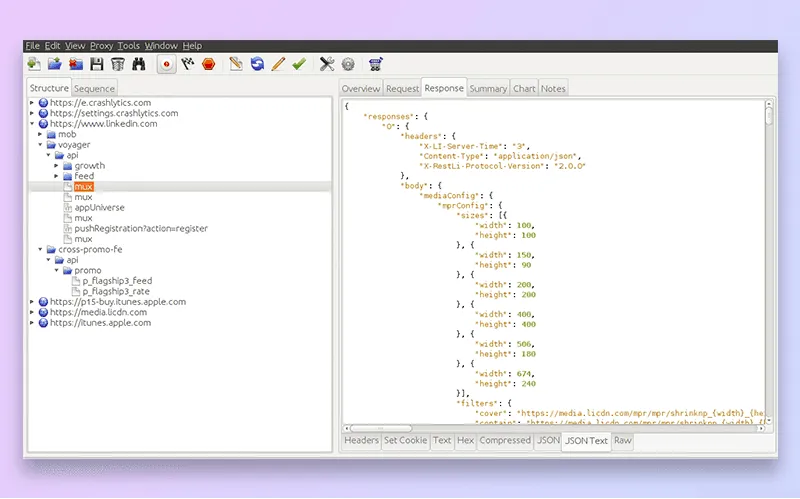
Charles Debugging Proxy: the tool for Android app testing
This tool is very popular due to it's high functionality, high performance, and user-friendly design. So that is why our engineers chose it as one of Android app testing services. We have a detailed guide to how to use Charles Web Debugging Proxy, feel free to read it.
Summing up all the above, we would like to add that our QA engineers are always striving to create the best product for you. And to perform all types of testing, they need several tools to do it. Our Android app development company always provides our specialists with all special software to ensure that your product will be high-quality. Do you have any question? Feel free to contact us. Subscribe to our blog as well to read all interesting news and not to miss something new.

Evgeniy Altynpara is a CTO and member of the Forbes Councils’ community of tech professionals. He is an expert in software development and technological entrepreneurship and has 10+years of experience in digital transformation consulting in Healthcare, FinTech, Supply Chain and Logistics
Give us your impressions about this article
Give us your impressions about this article